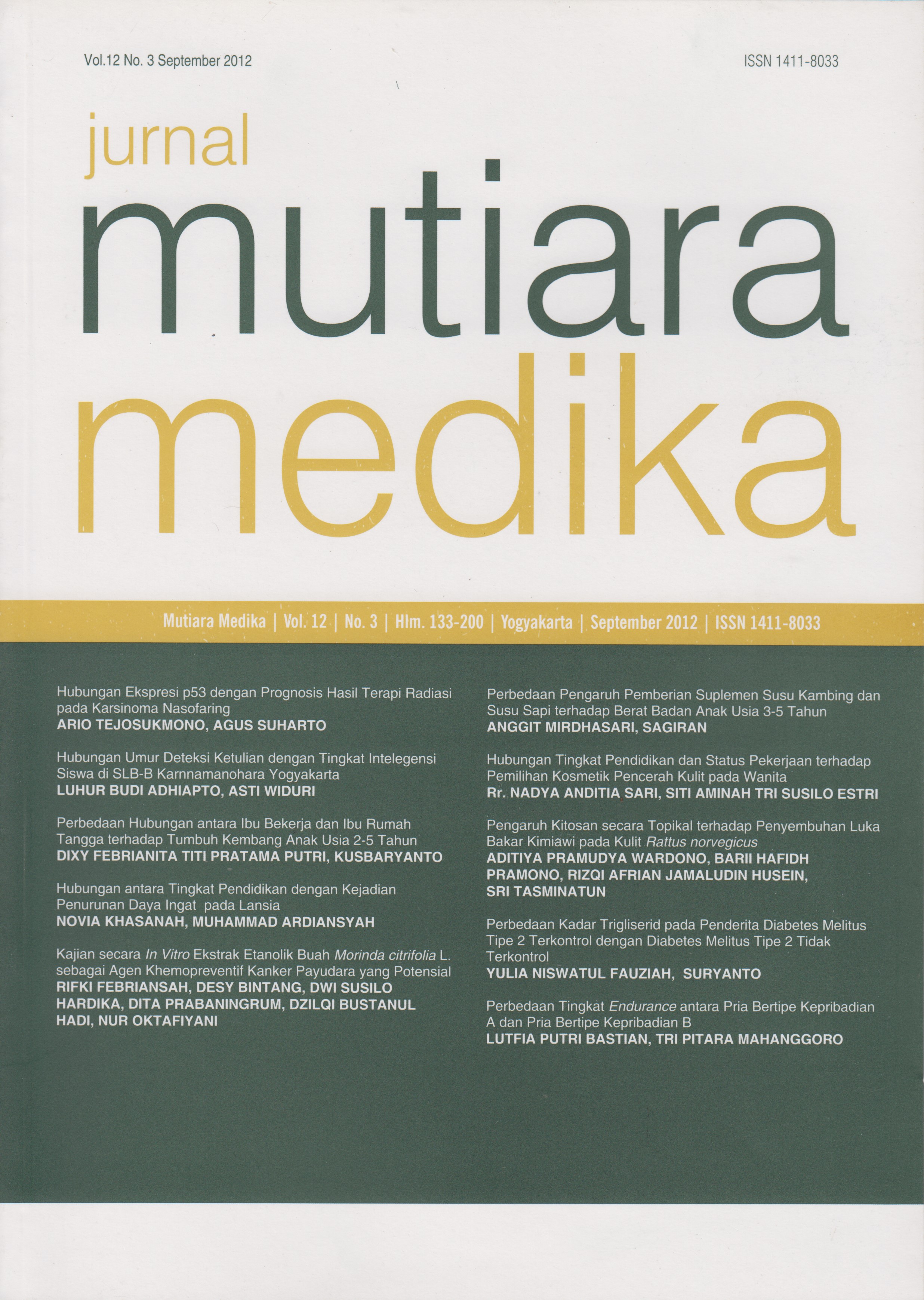Perbedaan Hubungan antara Ibu Bekerja dan Ibu Rumah Tangga terhadap Tumbuh Kembang Anak Usia 2-5 Tahun
DOI:
https://doi.org/10.18196/mmjkk.v12i3.1032Keywords:
pertumbuhan, perkembangan, ibu pegawai, ibu rumah tangga, anak usia 2-5 tahun, growth, development, mother as an employee, housewife mother, 2-5 years childrenAbstract
Terdapat hubungan antara wanita yang bekerja dengan tumbuh kembang anaknya. Penelitian ini bertujuan untuk mengetahui hubungan antara profesi ibu sebagai pegawai di perusahaan dan ibu rumah tangga dengan pertumbuhan dan perkembangan anak usia 2-5 tahun. Jenis penelitian ini adalah analytic observational dengan pendekatan cross sectional. Subyek penelitian adalah pasangan ibu seorang pegawai di perusahaan dan ibu rumah tangga (istri pegawai pria yang tidak bekerja) dengan anaknya yang berusia 2-5 tahun. Sampel yang digunakan sebanyak 80. Data dianalisis menggunakan uji Chisquare. Hasil uji statistik didapat nilai p=0,012 RR=0,38 (CI 95%: 0,16–0,86) untuk hubungan antara profesi ibu dengan perkembangan anak, sedangkan dengan pertumbuhan anak nilai p=0,330 RR=1,75 ( CI 95%: 0,55–5,51). Hubungan antara profesi ibu dengan pola asuh makan (p=0,120) dan pola asuh stimulus (p=0,172). Penelitian ini menunjukkan terdapat hubungan yang bermakna antara profesi ibu dengan perkembangan anak, namun tidak terdapat hubungan yang bermakna antara profesi ibu dengan pertumbuhan anak, pola asuh makan, dan pola asuh pemberian stimulus.
There is any relationship between working mother with growth and development her child. The objectives of this study are to determine the relationship between mother profession as an employee in the company and the housewife with the growth and development of 2-5 years children. This study is observational analytic with cross sectional approach. The subjects in this study are the mother of an employee in the company and housewife (wife of male employees who are not working) with their children aged 2-5 years. The samples used for as many as 80. The data were analyzed using Chi-square test. Results from statistical tests obtained the p=0.012 RR=0.38 (CI 95%: 0.16-0.86) for the relationship between mother’s profession with child development, while with child growth, p=0.330 RR=1,75 (CI 95%: 0.55-5.51). Relationship between mother’s profession with ate parenting (p=0,120) and stimulation parenting (p=0,172). Based on the result above shows there are significant relationships between mother’s professions with child development, but there’s no significant relationships between mother’s professions with child growth, ate parenting, and also with stimuli parenting.
References
Hariweni, T. Pengetahuan, Sikap dan Perilaku Ibu Bekerja dan Tidak Bekerja Tentang Stimulasi pada Pengasuhan Anak Balita. Karya Tulis Ilmiah strata satu, Universitas Sumatra Utara, Sumatra Utara. 2003.
Soetjiningsih. Tumbuh Kembang Anak (2nd ed). Jakarta: EGC. 1998.
Badan Pusat Statistik (BPS). Survei Demografi dan Kesehatan Indonesia (SDKI) 2002-2003. 2003.
Departemen Kesehatan Republik Indonesia. Pola Pemberian ASI dan Makanan. Jakarta. 2005.
Wong, L.D. dan Whaleys. Pedoman Klinis Asuhan Keperawatan Anak (M. Ester, penerjemah). Jakarta: EGC. 2004.
Susilo, Y.H. Problema Kualitas Anak Indonesia. Banjarmasin Post, 2001. p. A10.
Noor, S.R. Peran Perempuan dalam Keluarga Islami. 2002. Diakses 3 April 2009, dari sofiapsy.staff.ugm.ac.id
Anwar, HM. Peranan Gizi dan Pola Asuh dalam Meningkat Kualitas Tumbuh Kembang Anak. Medika; 2000. 26 (2): 104-111.
Mamesah, M. Ibu Bekerja Hambat Kecerdasan Anak. 2004. Diakses 6 May 2010, dari http:// portal.cbn.net.id/cbprtl/cyberwoman/detail. aspx?x=mother+and+baby&y=cyberwoman |0|0|8|775
Wayanti, S. Perbedaan Pola Asuh Ibu Bekerja dan Ibu Tidak Bekerja dalam Pencapaian Tumbuh Kembang Anak 4-6 tahun di TK Al Hasanah Yogyakarta. Karya Tulis Ilmiah strata satu, Universitas Gadjah Mada, Yogyakarta. 2002.
Sake, R. dan Rahman, T. Hubungan Interaksi Anak, Emotional Bounding, Konsumsi Makanan dam Penyakit Infeksi dengan Status Gizi Anak Usia 3-5 Tahun pada Keluarga Miskin di Kota Kendari. Risbinkes Poltekes Kendari. 2005.
Erlina, T.N. Hubungan Antara Pola Asuh Makan dengan Status Gizi Anak Balita usia 2 sampai 5 Ttahun di Desa Banjarmangu Kecamatan Banjarmangu Kabupaten Banjarnegara. Karya Tulis Ilmiah strata satu, Universitas Gadjah Mada, Yogyakarta. 2007.
Dewi, K.A. Perbedaan Kualitas Stimulasi Ibu pada Anak Usia Pra Sekolah Ditinjau dari Status Bekerja dan Tidak Bekerja [Abstrak]. Universitas Airlangga, Surabaya. 2010.
Kania, N. Stimulasi Tumbuh Kembang Anak Untuk Mencapai Tumbuh Kembang yang Optimal. 2006. Diakses tanggal 7 mei 2010, dari http://pustaka.unpad.ac.id/wp-content/ uploads/2010/02/stimulasi_tumbuh_ kembang_ anak_optimal.pdf
Cahyani, P.B., Hubungan Pengetahuan Ibu dengan Perkembangan Motorik Kasar Anak Usia 3-5 Tahun di Boyolali. Skripsi strata satu, Universitas Muhammadiyah Surakarta, Surakarta. 2009.
Downloads
Published
Issue
Section
License
Copyright
Authors retain copyright and grant Mutiara Medika: Jurnal Kedokteran dan Kesehatan (MMJKK) the right of first publication with the work simultaneously licensed under an Attribution 4.0 International (CC BY 4.0) that allows others to remix, adapt and build upon the work with an acknowledgment of the work's authorship and of the initial publication in Mutiara Medika: Jurnal Kedokteran dan Kesehatan (MMJKK).
Authors are permitted to copy and redistribute the journal's published version of the work (e.g., post it to an institutional repository or publish it in a book), with an acknowledgment of its initial publication in Mutiara Medika: Jurnal Kedokteran dan Kesehatan (MMJKK).
License
Articles published in the Mutiara Medika: Jurnal Kedokteran dan Kesehatan (MMJKK) are licensed under an Attribution 4.0 International (CC BY 4.0) license. You are free to:
- Share — copy and redistribute the material in any medium or format.
- Adapt — remix, transform, and build upon the material for any purpose, even commercially.
This license is acceptable for Free Cultural Works. The licensor cannot revoke these freedoms as long as you follow the license terms. Under the following terms:
Attribution — You must give appropriate credit, provide a link to the license, and indicate if changes were made. You may do so in any reasonable manner, but not in any way that suggests the licensor endorses you or your use.
- No additional restrictions — You may not apply legal terms or technological measures that legally restrict others from doing anything the license permits.






